Power CHEVROLET SUBURBAN 1994 Owners Manual
[x] Cancel search | Manufacturer: CHEVROLET, Model Year: 1994, Model line: SUBURBAN, Model: CHEVROLET SUBURBAN 1994Pages: 385, PDF Size: 19.88 MB
Page 14 of 385
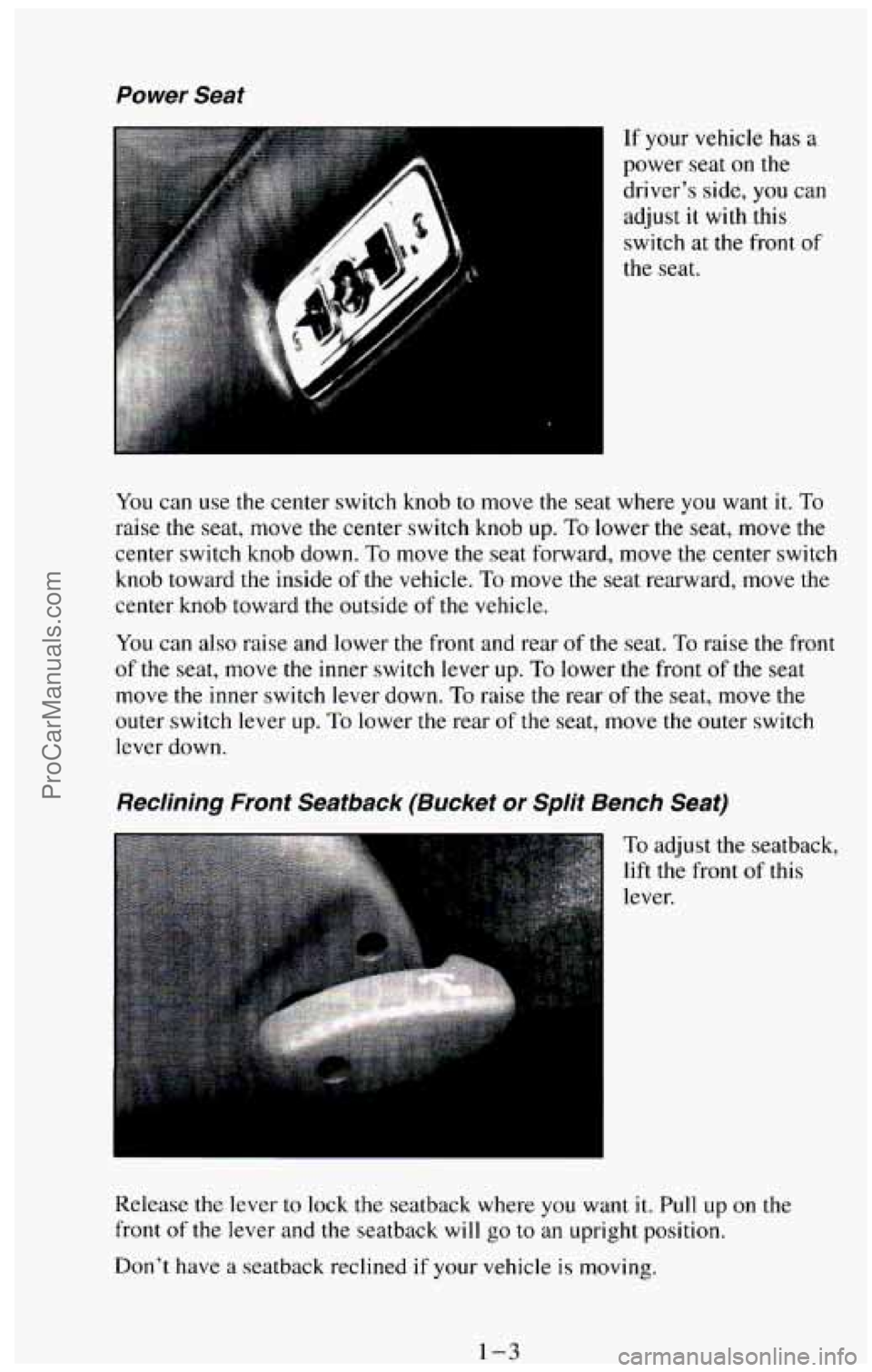
Power Seat
If your vehicle has a
power seat
on the
driver’s side,
you can
adjust
it with this
switch at
the front of
the seat.
You can use the center switch knob to move the seat where
you want it. To
raise the seat, move the center switch knob up. To lower the seat, move the
center switch knob down.
To move the seat forward, move the center switch
knob toward the inside
of the vehicle. To move the seat rearward, move the
center knob toward the outside of the vehicle.
You can also raise and lower
the front and rear of the seat. To raise the front
of the seat, move
the inner switch lever up. To lower the front of the seat
move the inner switch lever down.
To raise the rear of the seat, move the
outer switch lever up. To lower the rear of the seat, move the outer switch
lever down.
Reclining Front Seatback (Bucket or Split Bench Seat)
To adjust the seatback,
lift the front of this
lever.
Release
the lever to lock the seatback where you want it. Pull up on the
front
of the lever and the seatback will go to an upright position.
Don’t have
a seatback reclined if your vehicle is moving.
1-3 ProCarManuals.com
Page 61 of 385
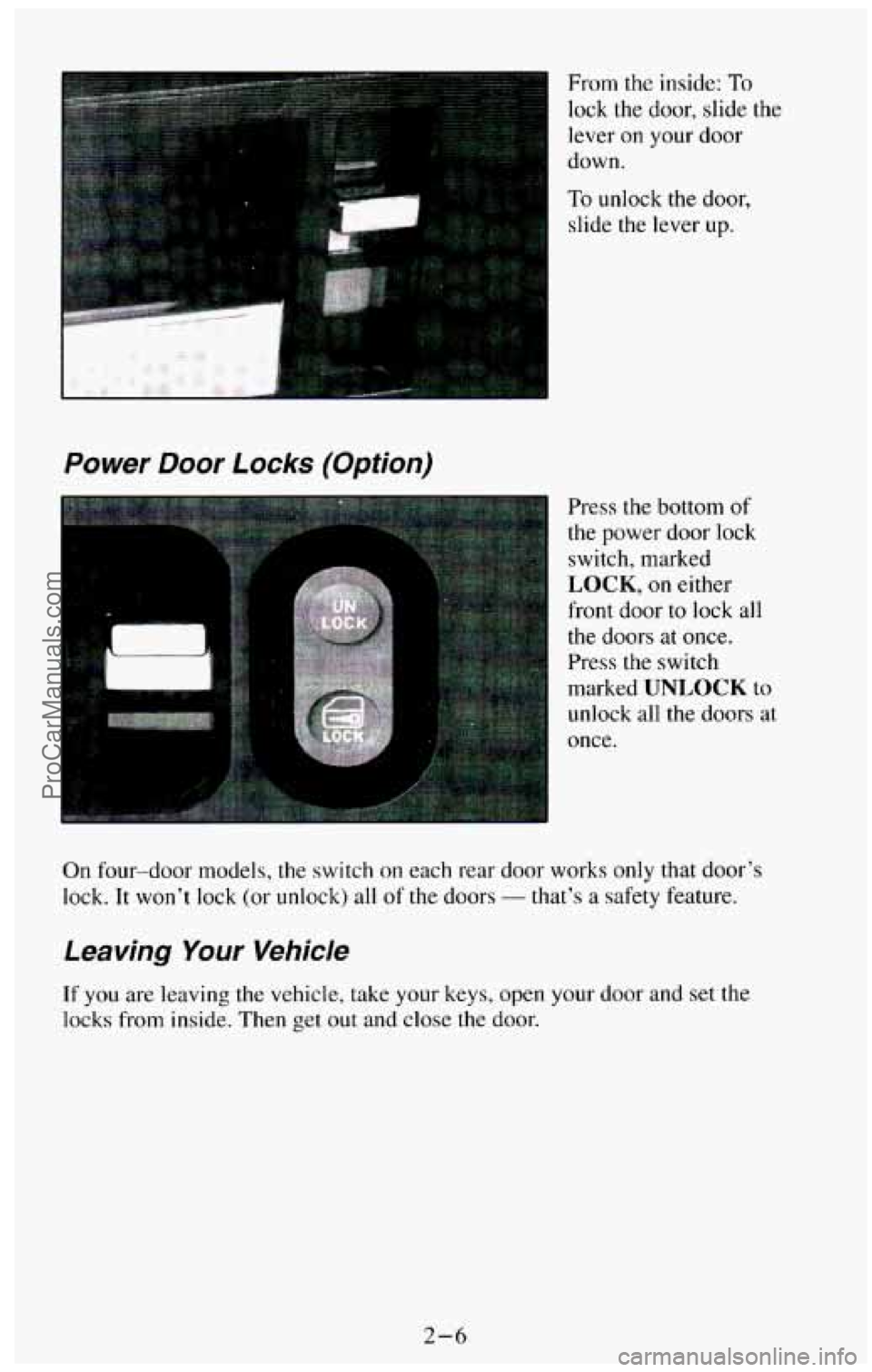
From the inside: To
lock the door, slide the
lever on your door
down.
To unlock the door,
slide the lever up.
Power Door Locks (Option)
Press the bottom of
the power door lock
switch, marked
LOCK, on either
front door to lock all
the doors
at once.
Press the switch
marked
UNLOCK to
unlock
all the doors at
once.
On four-door models,
the switch on each rear door works only that door’s
lock. It won’t
lock (or unlock) all of the doors - that’s a safety feature.
Leaving Your Vehicle
If you are leaving the vehicle, take your keys, open your door and set the
locks from inside. Then get out and close the door.
2-6
ProCarManuals.com
Page 65 of 385
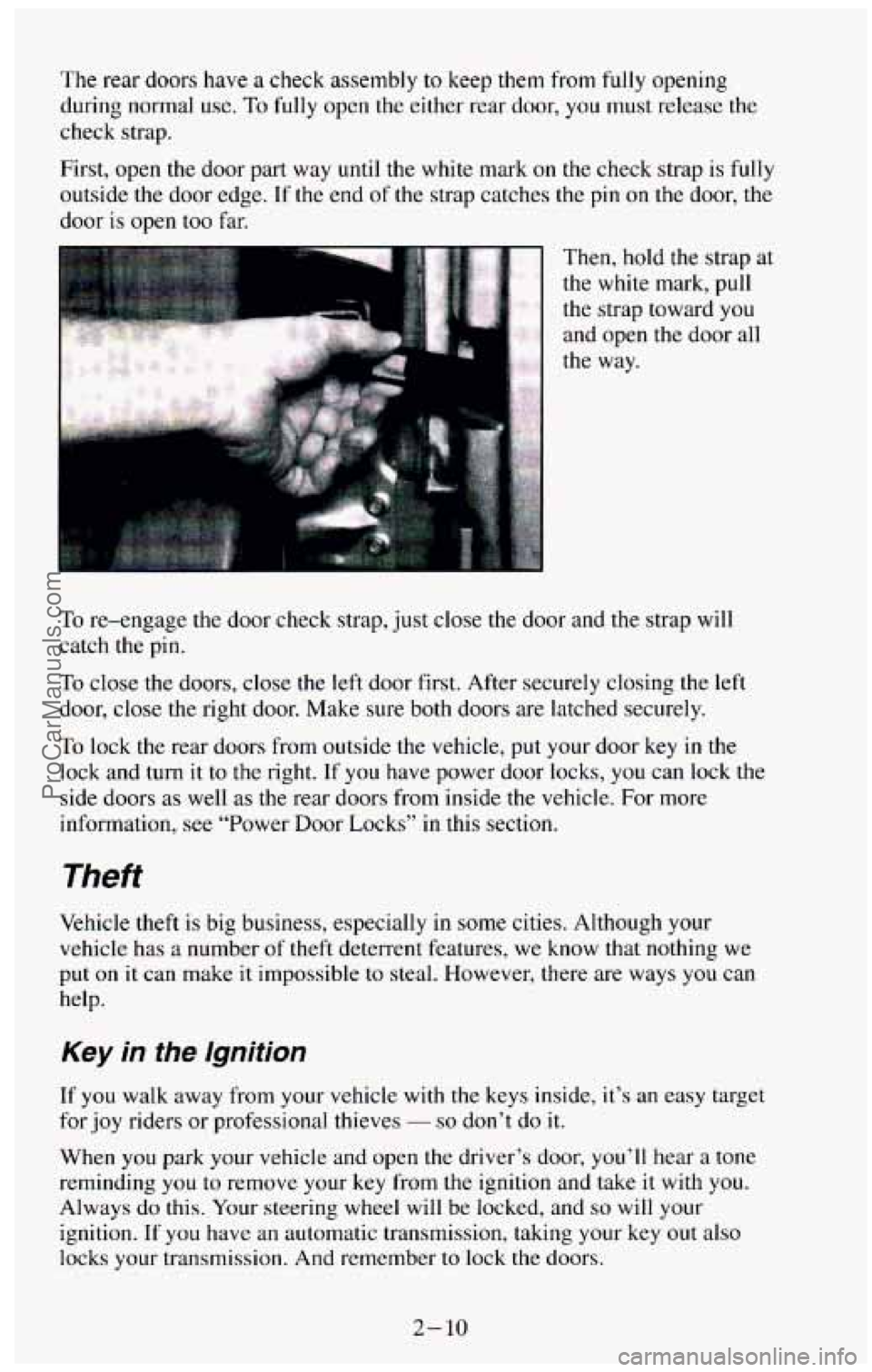
The rear doors have a check assembly to keep them from fully opening
during normal use.
To fully open the either rear door, you must release the
check strap.
First, open the door part way
until the white mark on the check strap is fully
outside the door edge. If the end of the strap catches the pin on the door, the
door is open too far,
Then, hold the strap at
the white mark, pull
the strap toward
you
and open the door all
the way.
To re-engage the door check strap, just close the door and the strap will
catch the pin.
To close the doors, close the left door first. After securely closing the left
door, close the right door. Make sure both doors are latched securely.
To lock the rear doors from outside the vehicle, put your door key in the
lock and turn it to the right. If you have power door locks, you can lock the
side doors as well as the rear doors from inside the vehicle. For more
information, see “Power Door Locks” in this section.
Theft
Vehicle theft is big business, especially in some cities. Although your
vehicle has a number of theft deterrent features, we
know that nothing we
put
on it can make it impossible to steal. However, there are ways you can
help.
Key in the lgnition
If you walk away from your vehicle with the keys inside, it’s an easy target
for
joy riders or professional thieves - so don’t do it.
When you park your vehicle and open the driver’s door, you’ll hear a tone
reminding
you to remove your key from the ignition and take it with you.
Always
do this. Your steering wheel will be locked, and so will your
ignition.
If you have an automatic transmission, taking your key out also
locks your transmission. And remember to lock the doors.
2- 10
ProCarManuals.com
Page 71 of 385
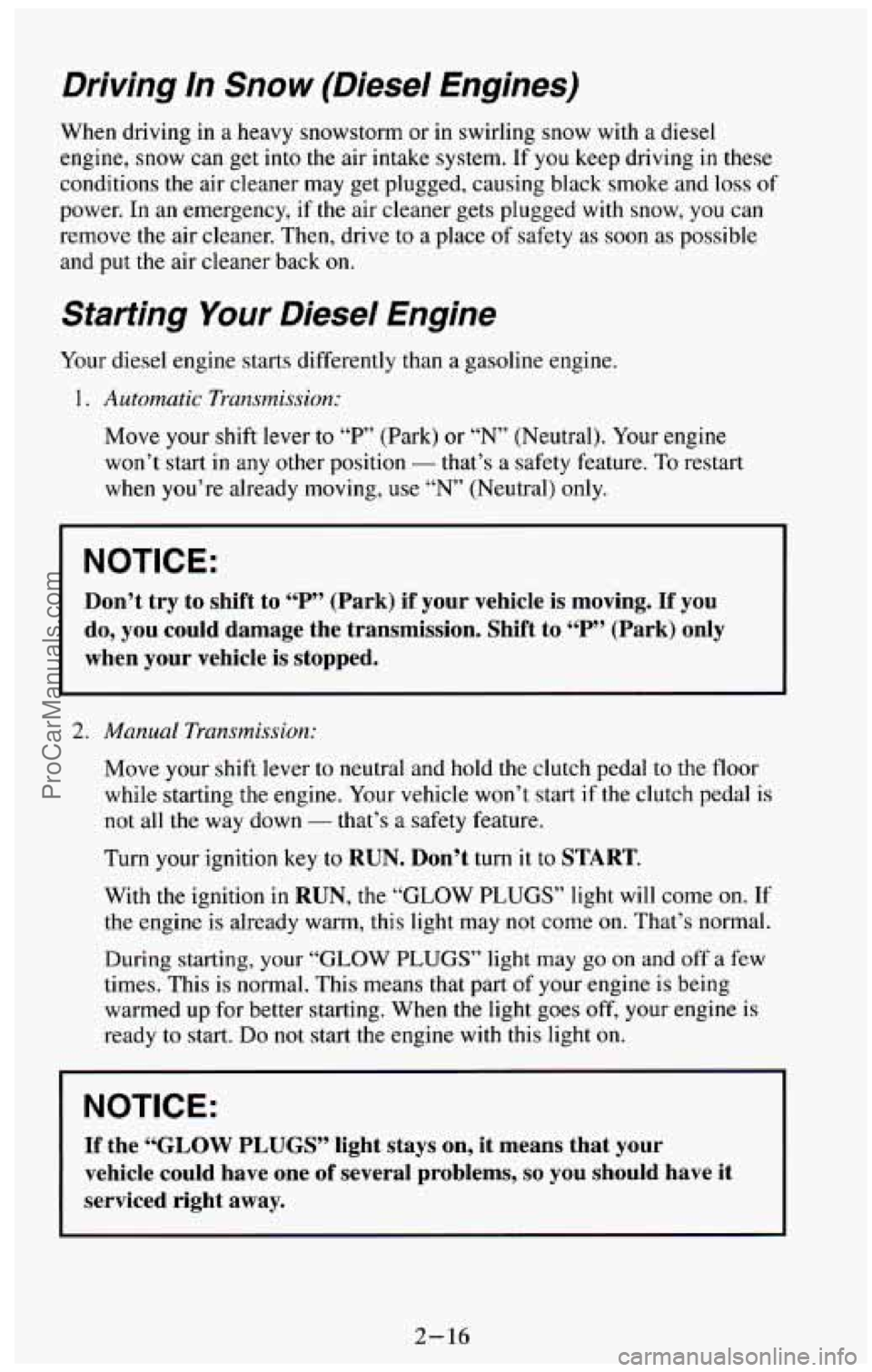
Driving In Snow (Diesel Engines)
When driving in a heavy snowstorm or in swirling snow with a diesel
engine, snow can get into
the air intake system. If you keep driving in these
conditions the air cleaner may get plugged, causing black smoke and loss of
power. In an emergency, if the air cleaner gets plugged with snow, you can
remove the air cleaner.
Then, drive to a place of safety as soon as possible
and put the air cleaner back
on.
Starting Your Diesel Engine
Your diesel engine starts differently than a gasoline engine.
1. Automatic Transmission:
Move your shift lever to “P’ (Park) or “N” (Neutral). Your engine
won’t start in any other position
- that’s a safety feature. To restart
when you’re already moving, use
“N” (Neutral) only.
NOTICE:
Don’t try to shift to 4‘P’’ (Park) if your vehicle is moving. If you
do, you could damage the transmission. Shift to
“P” (Park) only
when your vehicle is stopped.
2. Manual Transmission:
Move your shift lever to neutral and hold the clutch pedal to the floor
while starting
the engine. Your vehicle won’t start if the clutch pedal is
not all the way down - that’s a safety feature.
Turn your ignition
key to RUN. Don’t turn it to START.
With the ignition in RUN, the “GLOW PLUGS” light will come on. If
the engine is already warm, this light may
not come on. That’s normal.
During starting, your “GLOW
PLUGS” light may go on and off a few
times. This
is normal. This means that part of your engine is being
warmed up for better starting. When the light goes off, your engine is
ready to start.
Do not start the engine with this light on.
NOTICE:
If the “GLOW PLUGS” light stays on, it means that your
vehicle could have one
of several problems, so you should have it
serviced right away.
2-16
ProCarManuals.com
Page 77 of 385
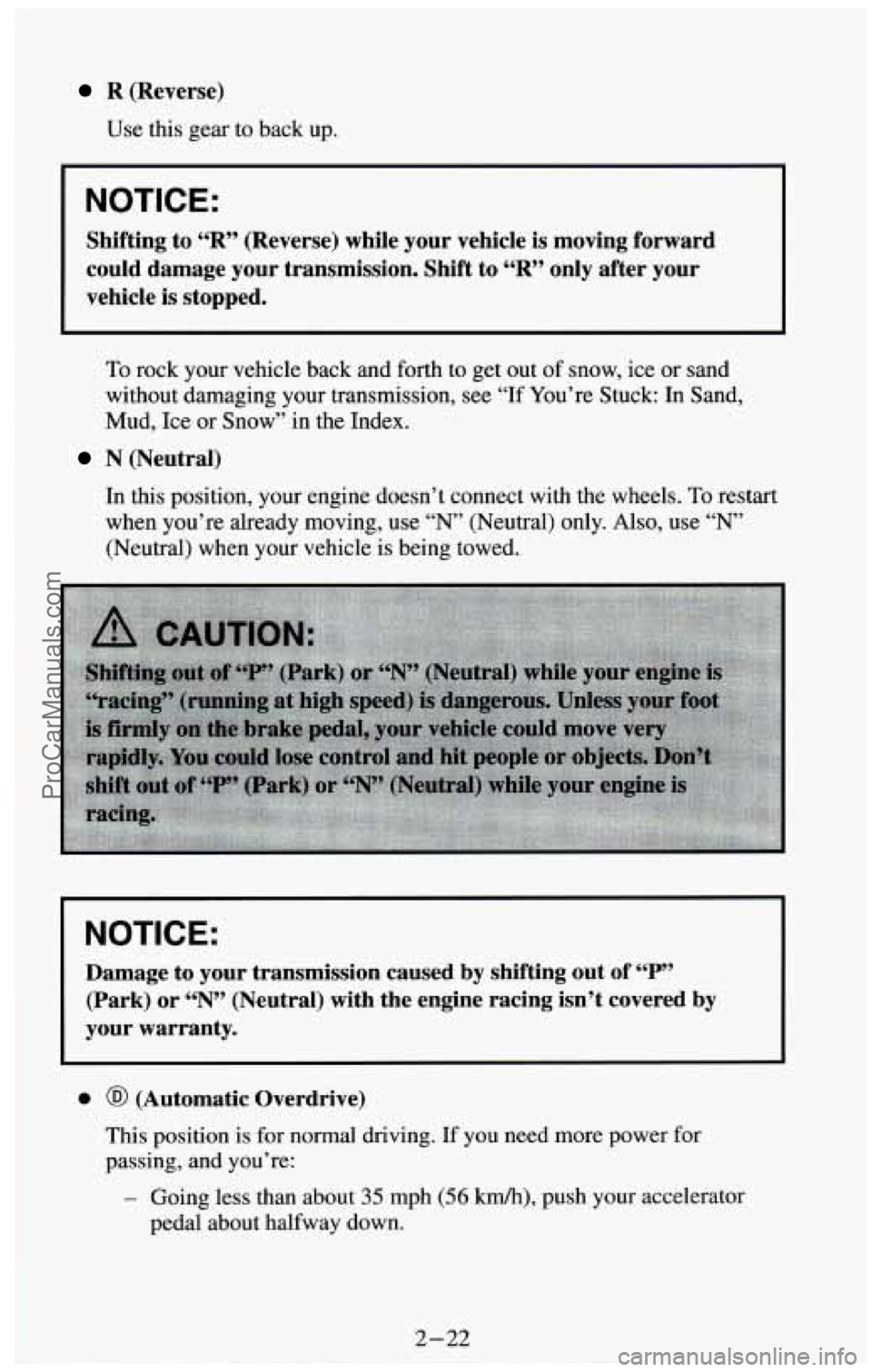
R (Reverse)
Use this gear to back up.
NOTICE:
Shifting to “R” (Reverse) while your vehicle is moving forward
could damage your transmission. Shift to
“R” only after your
vehicle is stopped.
To rock your vehicle back and forth to get out of snow, ice or sand
without damaging your transmission, see “If You’re Stuck: In Sand,
Mud, Ice or Snow’’
in the Index.
N (Neutral)
In this position, your engine doesn’t connect with the wheels. To restart
when you’re already moving, use
“N’ (Neutral) only. Also, use “N’
(Neutral) when your vehicle is being towed.
NOTICE:
Damage to your transmission caused by shifting out of “P”
(Park) or “N” (Neutral) with the engine racing isn’t covered by
your warranty.
0 @ (Automatic Overdrive)
This position is for normal driving. If you need more power for
passing, and you’re:
- Going less than about 35 mph (56 km/h), push your accelerator
pedal about halfway down.
I 2-22
ProCarManuals.com
Page 78 of 385
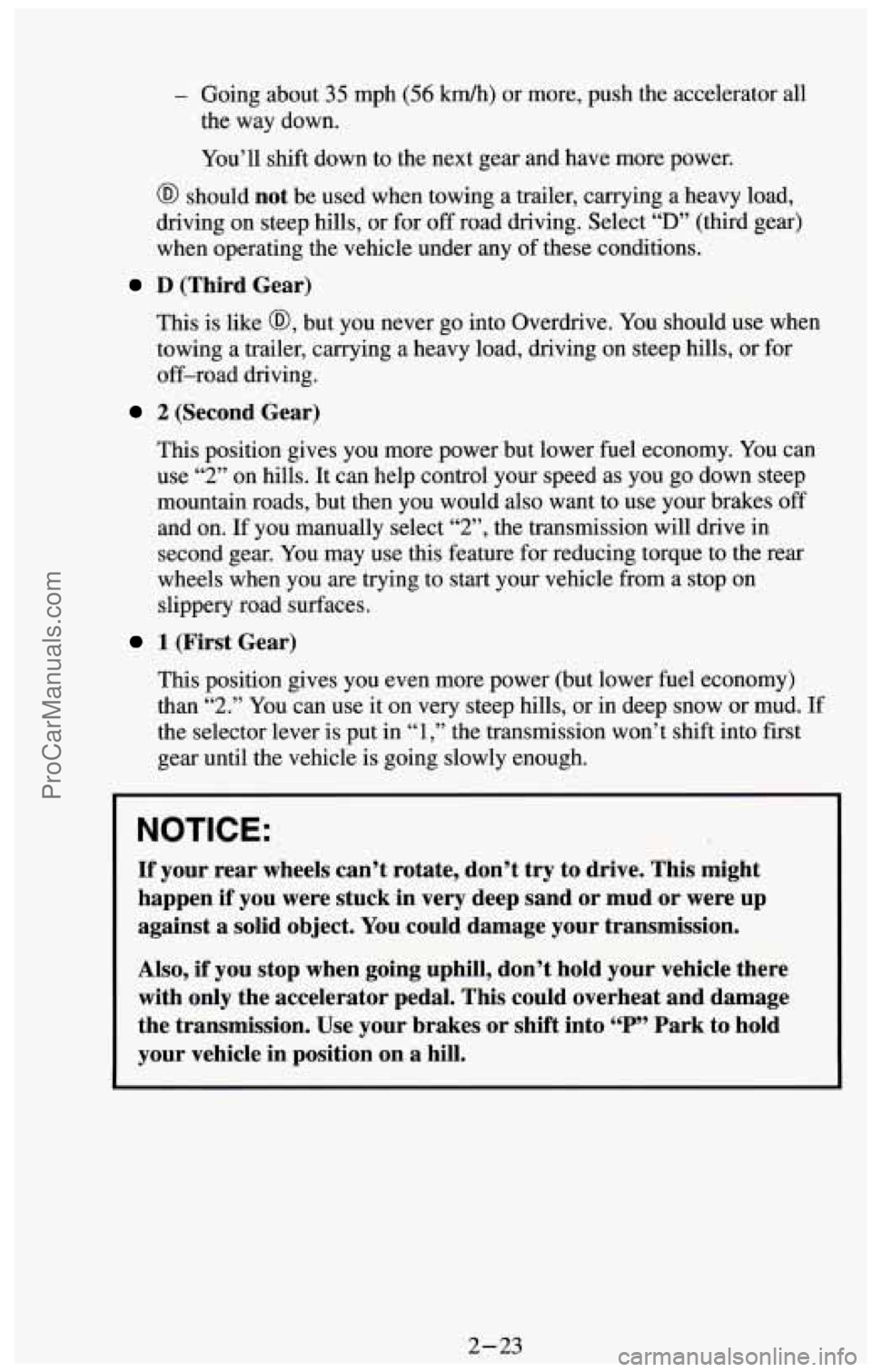
- Going about 35 mph (56 km/h) or more, push the accelerator all
the way down.
You’ll shift down to the next gear and have more power.
@ should not be used when towing a trailer, carrying a heavy load,
driving on steep hills, or for
off road driving. Select “D” (third gear)
when operating the vehicle under any of these conditions.
D (Third Gear)
This is like @, but you never go into Overdrive. You should use when
towing a trailer, carrying a heavy load, driving on steep hills, or for
off-road driving.
2 (Second Gear)
This position gives you more power but lower fuel economy. You can
use
“2” on hills. It can help control your speed as you go down steep
mountain roads, but then you would also want to use your brakes
off
and on. If you manually select “2”, the transmission will drive in
second gear.
You may use this feature for reducing torque to the rear
wheels when you are trying to start your vehicle from
a stop on
slippery road surfaces.
1 (First Gear)
This position gives you even more power (but lower fuel economy)
than
“2.” You can use it on very steep hills, or in deep snow or mud. If
the selector lever
is put in “1,” the transmission won’t shift into first
gear until the vehicle is going slowly enough.
NOTICE:
If your rear wheels can’t rotate, don’t try to drive. This might
happen if you were stuck in very deep sand or mud or were up
against
a solid object. You could damage your transmission.
Also, if you stop when going uphill, don’t hold your vehicle there
with only the accelerator pedal. This could overheat and damage
the transmission. Use your brakes
or shift into “P” Park to hold
your vehicle in position on
a hill.
2-23
ProCarManuals.com
Page 87 of 385
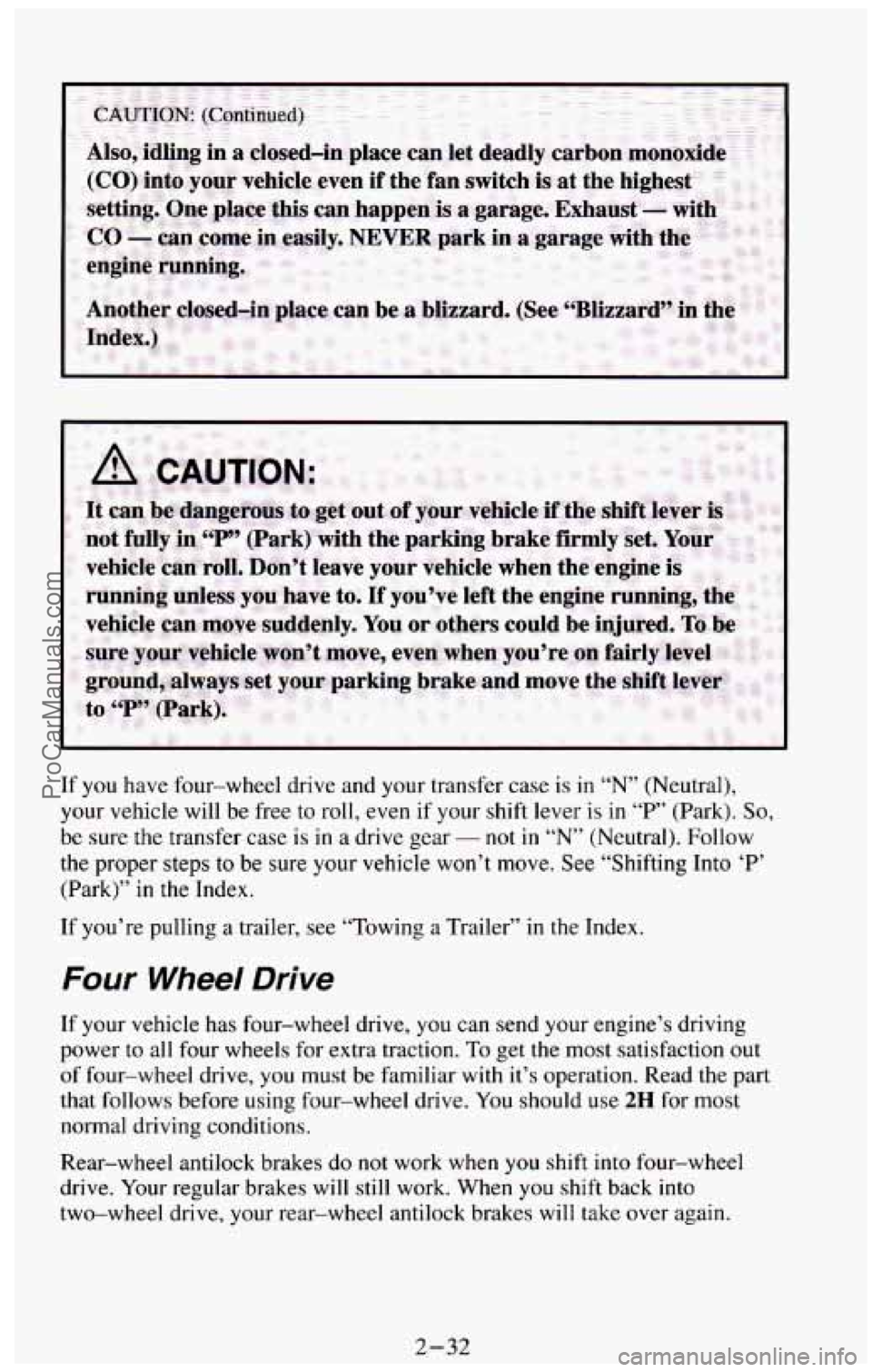
If you have four-wheel drive and your transfer case is in “N” (Neutral),
your vehicle will be free to roll, even if your shift lever is in
“P” (Park). So,
be sure the transfer case is in a drive gear - not in “N” (Neutral). Follow
the proper steps
to be sure your vehicle won’t move. See “Shifting Into ‘P’
(Park)” in the Index.
If you’re pulling a trailer, see “Towing a Trailer” in the Index.
Four Wheel Drive
If your vehicle has four-wheel drive, you can send your engine’s driving
power
to all four wheels for extra traction. To get the most satisfaction out
of four-wheel drive, you must be familiar with it’s operation. Read the part
that follows before using four-wheel drive.
You should use 2H for most
normal driving conditions.
Rear-wheel antilock brakes do
not work when you shift into four-wheel
drive. Your regular brakes will
still work. When you shift back into
two-wheel drive, your rear-wheel antilock brakes will take over again.
2-32
ProCarManuals.com
Page 89 of 385

When your headlights or parking lights are on, rotate the dial to the right of
your headlight switch up to brighten, or down to dim, your transfer case
indicator light.
2H (2-Wheel High): This setting is for driving in most street and highway
situations. Your front axle
is not engaged in two-wheel drive.
4H (&Wheel High): This setting engages your front axle to help drive your
vehicle. Use
4H when you need extra traction, such as on wet or icy roads,
or
in most off-road situations.
N (Neutral): Shift to this setting only when your vehicle needs to be towed
or when using a power take-off.
4L (4-Wheel Low): This setting also engages your front axle to give you
extra power, but should be used only for off-road driving.
You can shift from
2H to 4H or from 4H to 2H while the vehicle is moving.
Your front axle will engage faster if
you take your foot off of the accelerator
for a few seconds after you shift. In extremely cold weather
it may be
necessary to stop or slow the vehicle to shift out of
2H.
To shift into or out of 4L or N (Neutral):
Slow the vehicle to a roll, about 1-3 mph (2-5 kdh) and shift your
Shift the transfer case shift lever in one continuous motion.
transmission into neutral.
Don’t pause
in N (Neutral) as you shift the transfer case into 4L, or your
gears could clash.
Remember that driving in
4H or 4L may reduce fuel economy. Also, driving
in four-wheel drive on dry pavement could cause your tires to wear faster
and make your transfer case harder to shift.
Front Axle Locking Feature
The front axle locks and unlocks automatically when you shift the transfer
case. Some delay for the axle to lock or unlock is normal. If the outside
temperature is
very hot, or the vehicle has been used under hard driving
conditions, there may be a slight delay for the axle to unlock.
2-34
ProCarManuals.com
Page 90 of 385
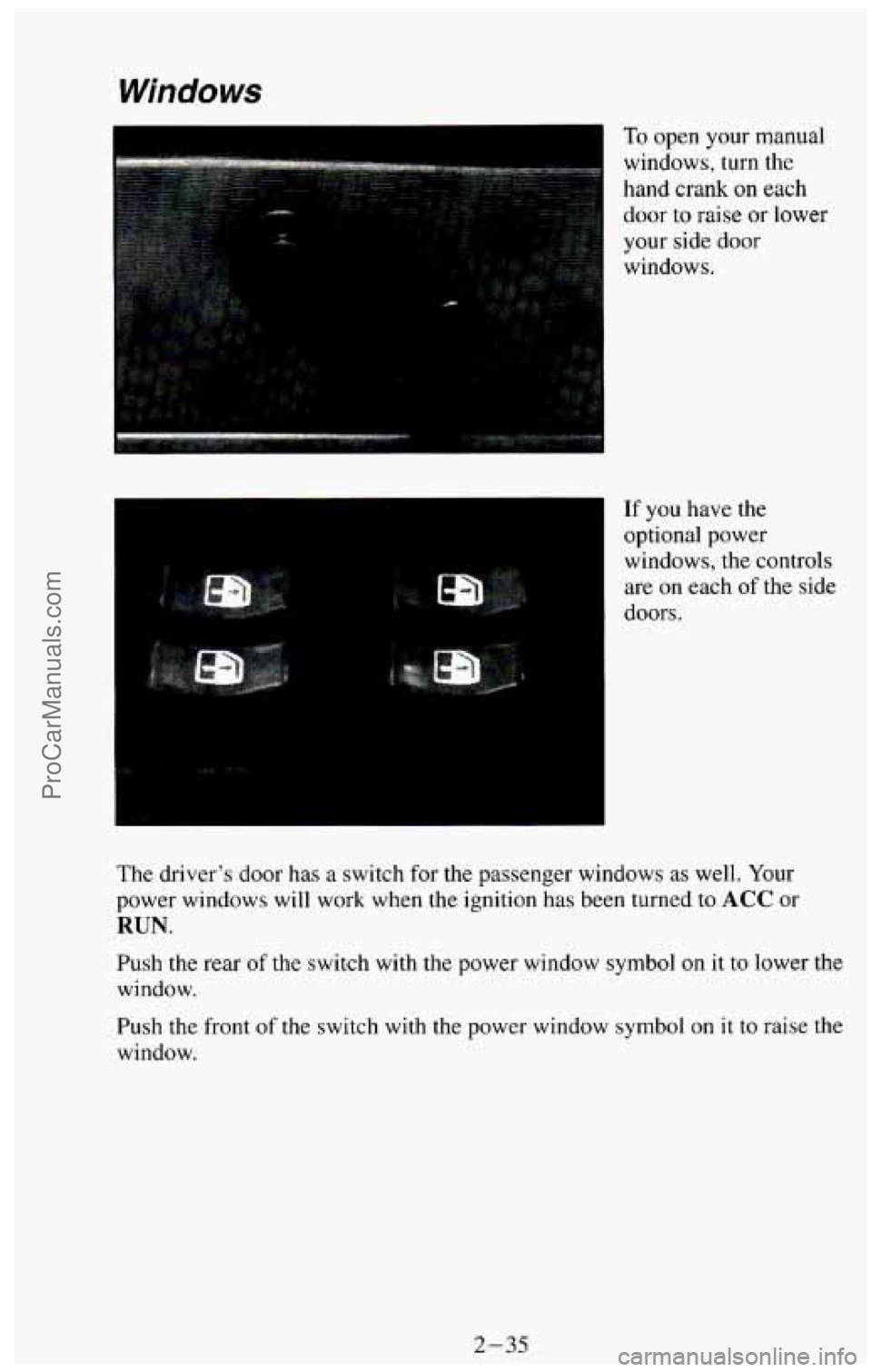
Windows
To open your manual
windows, turn the
hand crank
on each
door to raise or lower
your side door
windows.
If you have the
optional power
windows, the controls
are on each
of the side
doors.
The driver’s door has a switch for the passenger windows
as well. Your
power windows will work when the ignition has been turned to ACC or
RUN.
Push the rear of the switch with the power window symbol on it to lower the
window.
Push the front
of the switch with the power window symbol on it to raise the
window.
2-35
ProCarManuals.com
Page 149 of 385
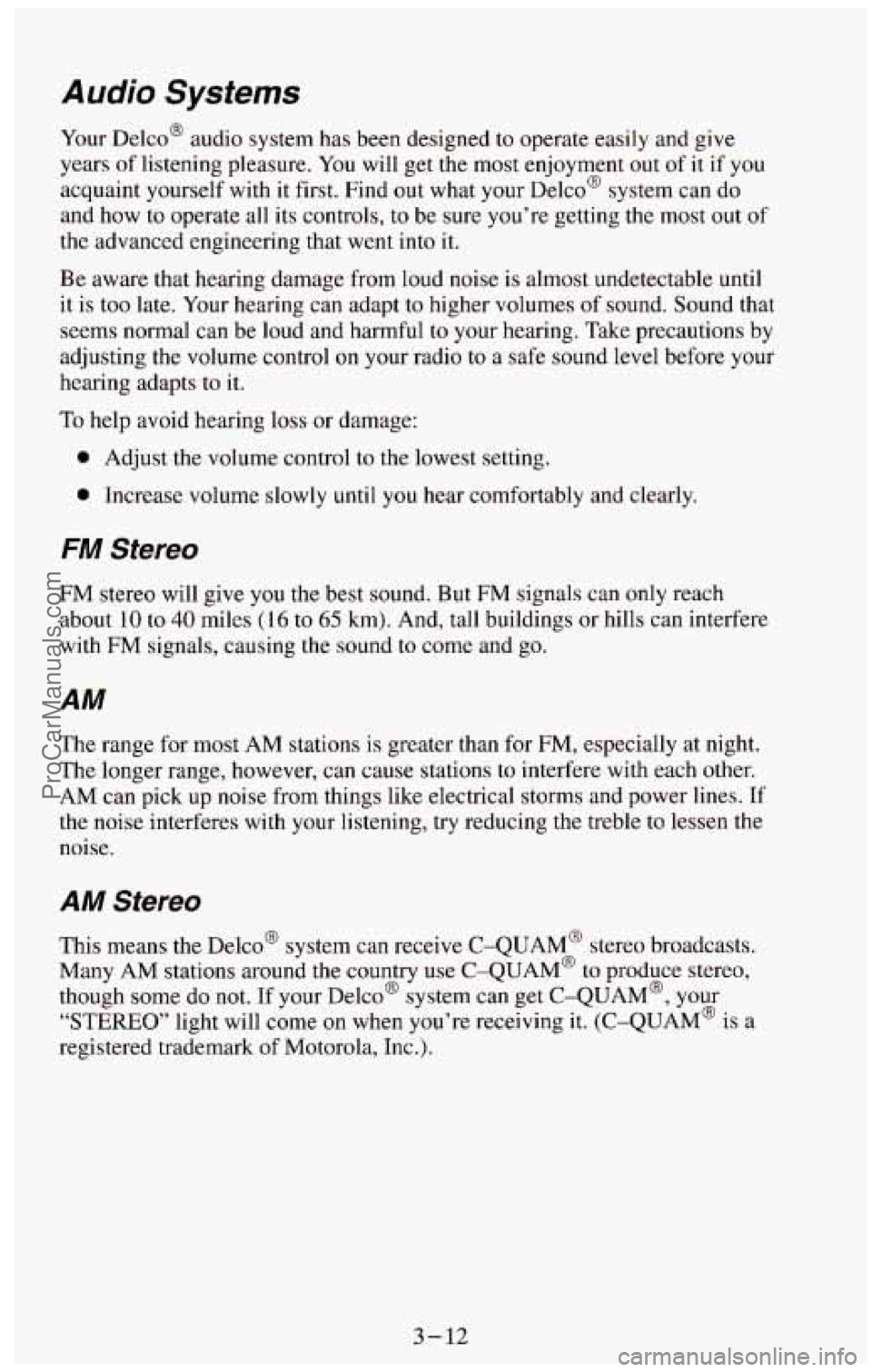
A udia Systems
Your Delco@ audio system has been designed to operate easily and give
years
of listening pleasure. You will get the most enjoyment out of it if you
acquaint yourself with it first. Find out what your Delco@ system can do
and how to operate all its controls, to be sure you’re getting the most out of
the advanced engineering that went into it.
Be aware that hearing damage from loud noise is almost undetectable until
it is too late. Your hearing can adapt to higher volumes of
sound. Sound that
seems normal can be loud and harmful to your hearing. Take precautions by
adjusting the volume control on your radio to
a safe sound level before your
hearing adapts to it.
To help avoid hearing loss or damage:
0 Adjust the volume control to the lowest setting.
0 Increase volume slowly until you hear comfortably and clearly.
FM Stereo
FM stereo will give you the best sound. But FM signals can only reach
about 10 to
40 miles (16 to 65 km). And, tall buildings or hills can interfere
with FM signals, causing the sound
to come and go.
AM
The range for most AM stations is greater than for FM, especially at night.
The longer range, however, can cause stations to interfere with each other.
AM can pick up noise from things like electrical storms and power lines.
If
the noise interferes with your listening, try reducing the treble to lessen the
noise.
AM Stereo
This means the Delco@ system can receive C-QUAM@ stereo broadcasts.
Many
AM stations around the country use C-QUAM@ to produce stereo,
though some
do not. If your Delco@ system can get C-QUAM@, your
“STEREO” light will come on when you’re receiving it. (C-QUAM@ is a
registered trademark of Motorola, Inc.).
3-12
ProCarManuals.com